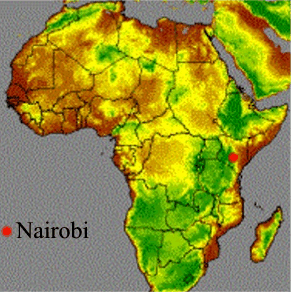 Why is there
a US Army medical research unit in Kenya? There are three principal reasons.
First, when American or allied troops travel in the tropics, they are
exposed to many diseases, such as malaria, dengue, and leishmaniasis, that do
not occur at home. Often, effective
methods for prevention or treatment of these exotic pathogens do not exist.
Because there is relatively little interest in the West in these
diseases, the US Department of Defense sponsors its own medical research, in
collaboration with Kenyan partners, for whom these diseases are not exotic but
daily threats. Second, pathogens do not
recognize international borders. Today,
the world is small place. Less than 30
years ago HIV was an unknown disease of monkeys in central Africa.
In 1999, New York City suffered, for the first time, an epidemic of West
Nile Virus. The spread of once rare
pathogens is increasingly frequent. Kenya
has an especially diverse pathogen fauna and USAMRU-K helps Kenya monitor for
emerging pathogens that could threaten it and eventually other countries.
Third, disease, economic development and security are entwined.
Improving the health of a country contributes to its stability, which
improves security for all countries. US
military medical research has had 100 years of illustrious accomplishment.
All of our research is transparent and all medical products are
immediately available to civilian populations world wide.
A recent example is the vaccine against hepatitis A, which was developed
at Walter Reed Army Institute of Research in the 1970s and extensively tested in
the US and throughout the world, including at research stations like USAMRU-K.
Why is there
a US Army medical research unit in Kenya? There are three principal reasons.
First, when American or allied troops travel in the tropics, they are
exposed to many diseases, such as malaria, dengue, and leishmaniasis, that do
not occur at home. Often, effective
methods for prevention or treatment of these exotic pathogens do not exist.
Because there is relatively little interest in the West in these
diseases, the US Department of Defense sponsors its own medical research, in
collaboration with Kenyan partners, for whom these diseases are not exotic but
daily threats. Second, pathogens do not
recognize international borders. Today,
the world is small place. Less than 30
years ago HIV was an unknown disease of monkeys in central Africa.
In 1999, New York City suffered, for the first time, an epidemic of West
Nile Virus. The spread of once rare
pathogens is increasingly frequent. Kenya
has an especially diverse pathogen fauna and USAMRU-K helps Kenya monitor for
emerging pathogens that could threaten it and eventually other countries.
Third, disease, economic development and security are entwined.
Improving the health of a country contributes to its stability, which
improves security for all countries. US
military medical research has had 100 years of illustrious accomplishment.
All of our research is transparent and all medical products are
immediately available to civilian populations world wide.
A recent example is the vaccine against hepatitis A, which was developed
at Walter Reed Army Institute of Research in the 1970s and extensively tested in
the US and throughout the world, including at research stations like USAMRU-K.
USAMRU-K has a central unit in Nairobi, field stations at Kisumu and Kericho, and temporary stations at Baringo, Kisii, coastal Kenya and Entasopia.
BACKGROUND
The success of that initial venture led to the establishment by cooperative agreement, of a broader endeavor at the Kenya Medical Research Institute (KEMRI) in 1979. USAMRU-K was the first American organization housed at KEMRI. Recent areas of interest have been malaria, leishmaniasis, arboviruses, vector dynamics, HIV, and enteric pathogens, with over 270 manuscripts published or in press from unit work. USAMRU-K is a special foreign activity of the Walter Reed Army Research Institute (WRAIR)-Washington DC. It is one of six US military research laboratories outside the United States, the others are located in Germany, Thailand, Indonesia, Peru and Egypt.
KEMRI, which is the principal research component of Ministry of Health, is composed of 10 centres. In Nairobi, USAMRU is sponsored by the Centre for Clinical Research, (CCR) and in Western Kenya, by the Centre for Vector Biology and Control Research, (CVBCR).
The Unit usually is staffed by 10 American clinicians and scientists, as well as about 150 Kenyan professional and technical personnel, all of whom are officially employees of KEMRI.
USAMRU-K collaborates with, among others, US Centers for Disease Control and Prevention (CDC) , African Medical and Research Foundation (AMREF), World Health Organization (WHO) Centre for Haemorrhagic Viruses and the Universities of Maryland, Michigan, and Oxford.